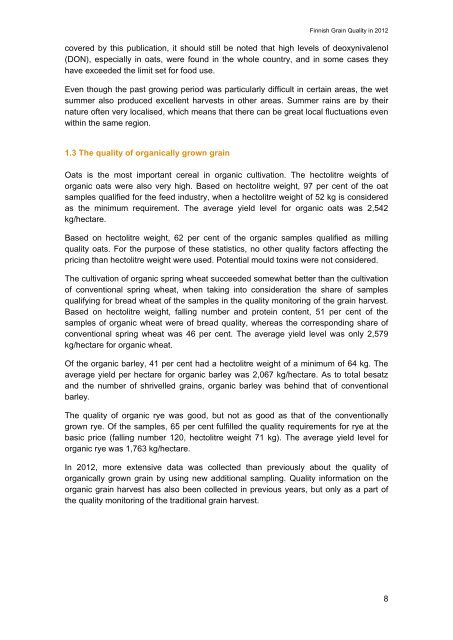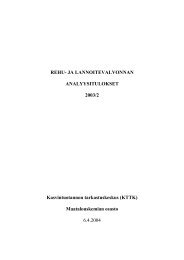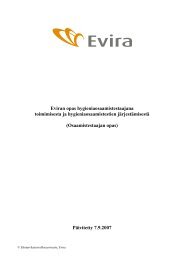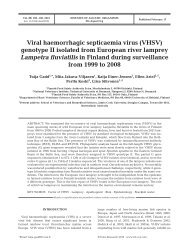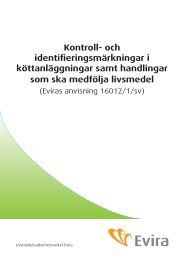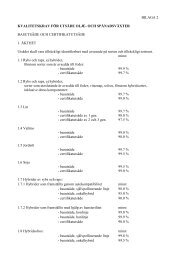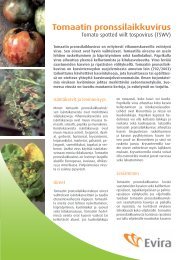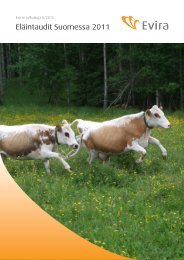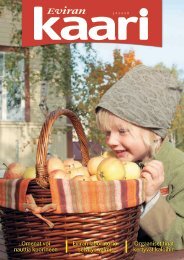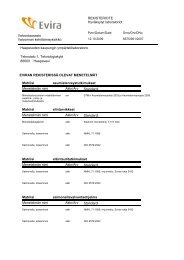Download PDF, 1698 kB - Evira
Download PDF, 1698 kB - Evira
Download PDF, 1698 kB - Evira
Create successful ePaper yourself
Turn your PDF publications into a flip-book with our unique Google optimized e-Paper software.
Finnish Grain Quality in 2012<br />
covered by this publication, it should still be noted that high levels of deoxynivalenol<br />
(DON), especially in oats, were found in the whole country, and in some cases they<br />
have exceeded the limit set for food use.<br />
Even though the past growing period was particularly difficult in certain areas, the wet<br />
summer also produced excellent harvests in other areas. Summer rains are by their<br />
nature often very localised, which means that there can be great local fluctuations even<br />
within the same region.<br />
1.3 The quality of organically grown grain<br />
Oats is the most important cereal in organic cultivation. The hectolitre weights of<br />
organic oats were also very high. Based on hectolitre weight, 97 per cent of the oat<br />
samples qualified for the feed industry, when a hectolitre weight of 52 kg is considered<br />
as the minimum requirement. The average yield level for organic oats was 2,542<br />
kg/hectare.<br />
Based on hectolitre weight, 62 per cent of the organic samples qualified as milling<br />
quality oats. For the purpose of these statistics, no other quality factors affecting the<br />
pricing than hectolitre weight were used. Potential mould toxins were not considered.<br />
The cultivation of organic spring wheat succeeded somewhat better than the cultivation<br />
of conventional spring wheat, when taking into consideration the share of samples<br />
qualifying for bread wheat of the samples in the quality monitoring of the grain harvest.<br />
Based on hectolitre weight, falling number and protein content, 51 per cent of the<br />
samples of organic wheat were of bread quality, whereas the corresponding share of<br />
conventional spring wheat was 46 per cent. The average yield level was only 2,579<br />
kg/hectare for organic wheat.<br />
Of the organic barley, 41 per cent had a hectolitre weight of a minimum of 64 kg. The<br />
average yield per hectare for organic barley was 2,067 kg/hectare. As to total besatz<br />
and the number of shrivelled grains, organic barley was behind that of conventional<br />
barley.<br />
The quality of organic rye was good, but not as good as that of the conventionally<br />
grown rye. Of the samples, 65 per cent fulfilled the quality requirements for rye at the<br />
basic price (falling number 120, hectolitre weight 71 kg). The average yield level for<br />
organic rye was 1,763 kg/hectare.<br />
In 2012, more extensive data was collected than previously about the quality of<br />
organically grown grain by using new additional sampling. Quality information on the<br />
organic grain harvest has also been collected in previous years, but only as a part of<br />
the quality monitoring of the traditional grain harvest.<br />
8


